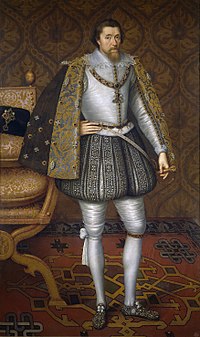
James VI and I (James Stuart) (19 June 1566 – 27 March 1625), King of Scotland, King of England and King of Ireland, faced many complicated religious challenges during his reigns in Scotland and England.
In Scotland, he inherited a reformed church, the Kirk, which was attempting to rid the country of bishops, dioceses, and parishes and establish a fully Presbyterian system, run by ministers and elders. However, James saw the bishops as the natural allies of the monarchy and frequently came into conflict with the Kirk in his sustained effort to reintroduce an episcopal polity to Scotland.
On his succession to the English throne in 1603, James was impressed by the church system he found there, which still adhered to an episcopate and supported the monarch's position as the head of the church. On the other hand, there were many more Roman Catholics in England than in Scotland, and James inherited a set of penal laws which he was constantly exhorted to enforce against them. Before ascending the English throne, James had assured the Earl of Northumberland that he would not persecute "any that will be quiet and give but an outward obedience to the law," but he soon reinforced strict penalties against Catholics. Partly triggered by Catholics' disillusionment with the new king, the Gunpowder Plot of 1605 led to a new wave of anti-Catholicism and even harsher legislation. In 1606, an oath of allegiance was introduced, though its enforcement later slackened.[1] His policy of seeking a Spanish Match for his son, Charles, Prince of Wales, produced widespread opposition, particularly in the Commons, where members feared a revival of Catholic power in the country and a threat to the Protestant monarchy and state.
- ^ Krugler, p. 20–24.
